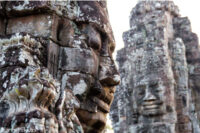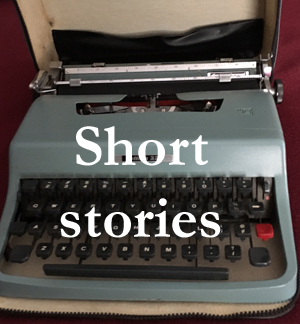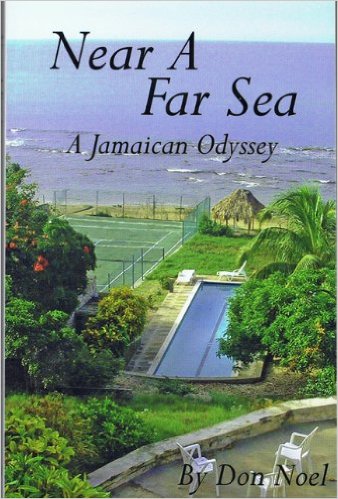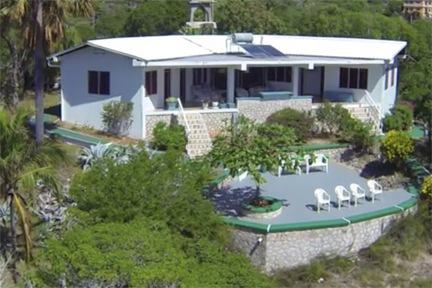First published in Lowestoft Chronicle #43, September 2020
Among the towers of the Bayon, a temple complex in northwest Cambodia, are 200 smiling, complacent faces of the Buddha. Most of them are two or three yards wide, massive carved blocks of sandstone fitted together almost seamlessly, a proud legacy of sculptor artisans in the service of a long-ago Khmer empire.
Cambodia, are 200 smiling, complacent faces of the Buddha. Most of them are two or three yards wide, massive carved blocks of sandstone fitted together almost seamlessly, a proud legacy of sculptor artisans in the service of a long-ago Khmer empire.
Many of those serene faces, when I first saw them five decades ago, were still enwreathed in the thick, fleshy roots of the tropical forest that had grown over them, from which they had only recently been — partially — freed. Still ensnared and so diminished by the remnant tuberous arteries and veins of giant trees, they seemed nonetheless tranquil, halcyon.
Serene, but omnipresent — like the benign surveillance I experienced there.
![]() The Vietnam War was raging next door. I had a journalistic fellowship to study economic development, notably on the Mekong River, which neutral Cambodia shared with the antagonists in that war. Until my wife and family joined me, I was the only American resident in the country, and was soon aware that my activities were being watched.
The Vietnam War was raging next door. I had a journalistic fellowship to study economic development, notably on the Mekong River, which neutral Cambodia shared with the antagonists in that war. Until my wife and family joined me, I was the only American resident in the country, and was soon aware that my activities were being watched.
I owed my admission to the intervention of a Quaker friend. He had a year earlier run an international seminar that won the praise of Norodom Sihanouk, Cambodia’s prince/leader, known to most of his educated citizenry as “Monseigneur.” I’d been granted a visa, but had been asked no detail. My first errand, on arrival in Phnom Penh, was a trip to the royal offices to ask what permissions I might need to travel, interview officialdom and conduct my studies.
Bring us a letter explaining what you’d like to do, I was told by Monseigneur’s aide-de-camp.
I was back a day later with a two-page letter, typed with my (then-state-of-the-art) flyweight companion. It was an ambitious catchall list of everywhere I might conceivably go and everyone I might want to interview.
We’ll show it to him, I was told; we’ll call you.
I retired to my un-airconditioned third floor “student room” in the Hotel le Royale, which after a little exploration I’d chosen as no more expensive than a commercial lodging downtown. A bonus: I was ensconced in the hub of almost all diplomatic and international-visitor activity, as it remains to this day.
During hot hours in my room, I doubled down on language study, boning up on the collegiate French that would be my essential lingua franca for the next five months. I hired a cyclopousse — a kind of bicycle chair pedaled from behind — to make a wide circuit of the capital city, getting to know it. I found a nearby restaurant with a peppery Vietnamese breakfast soup that prompted a cooling sweat on mornings that were at daybreak already hot and humid. And I grew a bit apprehensive.
Within the week, though, I was relieved. The pleasant man at the front desk – a helpful concierge who was apparently pleased to have an American in residence but displayed no awe at relaying a royal summons – told me I was invited to return.
The Prince’s aide welcomed me, and handed back my letter. Next to every item I’d enumerated was a scrawled “D’accord” – okay. At the foot was a single initial:
N for Norodom.
How should I use it? I asked. Just show it to anyone, I was assured. Trying not to show my skepticism, I thanked the aide, and went home to plan my work.
Skepticism proved unwarranted: That letter became my passport, unfailingly recognized as authentic.
An early example: A few days later, I took a chaloupe riverboat to a small provincial capital upriver on the Mekong, where I had arranged a series of interviews with agriculture-improvement agents. Arriving in mid-afternoon the day before, I checked into the only decent hotel in town and then wandered out to get a feel for back-country Cambodia. Peering into a schoolyard, I was challenged by a security guard and taken to the principal, who asked what I was about.
I tried to explain; he interrupted to ask if I had some credentials. Hesitantly, I offered him the letter.
“C’est l’écriture de Monseigneur!” he exclaimed – and proceeded to welcome me, order tea, and show me proudly around his school.
The Prince’s handwriting – that Napoleonic N . Everyone seemed to know it.
The fact that I traveled with that talisman in my pocket hardly spared me close official scrutiny. For example: There were always a half-dozen cyclopousses, pedicabs, lined up at a kind of taxi-stand outside the hotel. It was soon apparent, though, that only one pedaled up when I appeared; no others competed for my business. If I had that man take me to a ministry office and dismissed him, he was nonetheless waiting when I emerged an hour later.
I assumed he must report my travels to someone. Before I left the country, I cajoled him (well, all right, tipped him handsomely) into confirming my suspicions: He was grilled weekly by the national police.
In my second month, I traveled up-country to Battambang to visit another series of farm projects, then awarded myself a two-day pleasure visit to the Angkor complex, the seat of the Khmer Empire that ruled Southeast Asia for almost six centuries, from 802 to 1431 AD [or CE].
Nowadays the temples are a tourism mecca, almost completed freed from the jungle’s clasp. The host city, Siem Reap, is crowded with hotels, restaurant and shops for visitors – some two million of whom come annually.
Canny guides, I learned on a recent return visit, suggest that one come to watch dawn break behind the main temple (the iconic one on the national flag) — and then sit, meditate on the experience or find another way to kill fifteen minutes. The many hundreds who have come to see a glowing orb rise over exotic architecture almost all go back to their hotels for breakfast. One can then, for an hour or so, have the temples and their elaborate stone carvings to oneself.
That’s how to avoid crowds today. Five decades ago, no effort was needed: Visitors were occasional, the town was a sleepy backwater, and the restoration was very much a work in progress.
Angkor Wat is an enormous complex. (The name means “capital city temples”.) Originally a Hindu center, in its second century it became a Buddhist site when the imperial family adopted a new religion. One of the last emperors commissioned the Bayon (the name is an erroneous transcription of the banyan tree under which the Buddha achieved enlightenment). The giant stone Buddha faces are said to have been modeled after the emperor who commissioned them, Jayavarman VII himself.
The Angkor empire’s demise, almost six centuries after its founding, is still something of a mystery: A gradual hardening of the civic arteries? A move of the capital to Phnom Penh on the navigable Mekong as regional trade became important to the economy? A series of climate disasters? A sudden, finally successful, Thai invasion? Perhaps all the above.
In any case, by the 18th century and perhaps earlier, the metropolis had been abandoned. Over time, accumulating dust and dirt and vegetative debris buried the proud architecture under massive earthen mounds, through which grew an equally gargantuan tropical jungle. The once-teeming area was thinly populated by Khmer farmers and fishermen who knew dimly, if at all, of their imperial predecessors.
Today, only a few monuments are still strangled by tree roots – and those few have been deliberately left that way to illustrate for tourists how the entire complex must have looked a century earlier.
On my 1966 first visit, however, there were still hundreds of buildings and columns and busts caught in the mighty embrace of trees whose tops had been shorn. Colossal stones had been wedged apart by tree roots that grew over time from tiny filaments into tubers as thick as a man’s thigh, strong enough to lift and lever carved blocks as big as refrigerators, often spilling them to the ground.
I sought out some of the French archaeologists who were restoring the complex and training a generation of Cambodian cohorts. They painstakingly examined those stones – sometimes first prying them free of their tropical chokeholds – and marked them in colored paint to remember where they’d come from, and to describe or conjecture how they might be put back together.
Once duly recorded, the stones were lined up as neat and orderly as army recruits, ready for later reconstruction. Everywhere I went were rows of great stones, turned to make the archeologists’ painted notes visible; I was reminded of checkers pieces waiting to be put into play.
Having for the moment sated my appetite for sandstone antiquity, I found my way in late afternoon of that first day back to the Hotel de la Paix, a sprawl of bungalow buildings, for a shower and nap, then re-emerged to visit the hotel’s simple but handsome garden restaurant.
I’d hardly ordered a glass of wine and begun to study the menu when a Cambodian man approached. Was I alone, as he was? he asked in French. Might I welcome company at my table?
I was always constitutionally and professionally eager to meet the people whose places I visited, so I of course welcomed him. The waiter came to take orders, and we began with small talk: the weather, the ambience, the historicity of Siem Reap and Angkor. My rusty French was up to the occasion.
And how had I spent my day? he asked.
I’m not sure whether it was the way he asked, or the concentration with which he awaited my answer. In any case, I knew immediately what was afoot.
He was supposed to report on my activities, wasn’t he? I asked. I made it more a statement than a question. Did he want to take notes? If so, I wouldn’t mind.
His relief was evident. He’d missed his intended bus up from Phnom Penh, and when he finally arrived hadn’t known where to find me. He would appreciate any detail I could offer, he said enthusiastically, and yes, it would be a huge convenience if he could take notes. He took out a notebook and ballpoint pen.
The bare facts didn’t take long, and evolved over a leisurely meal into a relaxed conversation that gave me a better appreciation of how Angkor antiquity fit into modern Cambodians’ understanding of themselves. My spy – even now, I hesitate to unmask him by name — suggested a few things I might add to my next day’s itinerary. You might say that I gave him the day off by promising to meet for dinner again for a full accounting.
On that second evening, I explained that my family would join me the next day, flying from Japan into Siem Reap. The kids were five and seven; my wife and I would give them an uncomplicated tour of this historic site for the next two days, and then we’d all fly back to Phnom Penh to take up residence in a modest bungalow I’d found behind the Hotel le Royale.
My shadow was delighted, and wanted to help make arrangements. For example: It was possible to tour a part of the temple complex on an elephant; he couldn’t pay for it, but would speak to someone to be sure that we were understood as friends of Monseigneur and so not to be cheated. And he was insistent that we spend our last day getting to know the Great Lake.
I would probably have found the elephant — which the kids of course loved – by myself. But I might have missed the lake, one of the world’s remarkable natural phenomena and site of an extraordinary agricultural exchange – which should even now be on anyone’s bucket list.
By the end of the monsoon season, the Mekong rises something like 30 feet — enough to reverse the flow of a major tributary, the Tonlé Sap, where the two converge at Phnom Penh. The flooding Mekong sends huge amounts of water upstream to swell the Great Lake (also, confusingly, called the Tonlé Sap) into the largest lake in Southeast Asia, half the size of our Lake Erie.
I’d been in Phnom Penh when the rains ended. Soon, the Tonlé Sap reversed course to begin flowing toward the sea again, an event celebrated elaborately as the “changing of the waters,” still one of Cambodia’s premier festivals. By the time I got to Angkor, the lake was still huge, but was draining noticeably. And the millions of fish that had been hatched in the shallow waters at the edge of the swollen lake were now trapped by miles and miles of tall bamboo fences that had been driven through the water, from boats, to firm footing in the lakebed.
What we witnessed must have been going on since the glory days of Angkor Wat: As the water receded further, tens of thousands of fish — confined by the bamboo fences — could literally be bailed out by the bucketful. They were then crushed, salted and fermented into a fish paste called prahok – an evil-smelling concoction that is superbly preserved (and must be an acquired taste). And then the farmers farther inland came in oxcarts carrying huge sacks of their recently-harvested rice, to be traded for huge tubs of prahok that would be their primary protein through the dry season.
All this was plain to see; our kids readily understood, and marveled along with their parents. As my shadow had urged, we also took a boat out onto the lake and had a simple lunch at a floating restaurant – further delight for the children — before heading back to Siem Reap and preparing to fly back to the capital.
I met my spy one more time that night, giving him a detailed accounting of our day and thanking him for his advice. I assume that his report to the head spies in Phnom Penh made it seem he’d successfully shadowed me every waking hour. I assume, too, that it made me out as an innocuous family man and an admirer of Khmer culture who posed no political threat to Cambodia.
But if so, his testimonial made no difference; I was shadowed the entirety of my remaining three months in the country.
I understood: The United States was engaged in an ugly war next door, and there were incessant (and I concluded erroneous) rumors of Viet Cong war hospitals just inside the Cambodian borders. My family and I were still the only resident Americans. Any military-police establishment worth its salt would of course want to keep me under surveillance — even if they were only halfway good at it.
Norodom Sihanouk was aware of me. When from time to time the diplomatic corps was summoned to the Vietnam border where the war had spilled into a neutral Cambodian village, I (also the only foreign journalist in the country) was always invited, and was directed to stand next to the Chinese ambassador, who spoke English but no French. Monseigneur would vent his outrage in French as he pivoted slowly around the circle of a dozen or more ambassadors, then would switch seamlessly to English when he came to the two of us.
On one occasion, he publicly acknowledged me. It was during GANEFO — the propaganda-laden Games of the New Emerging Forces, a wannabe Olympics that China staged in Cambodia. I had eased up to take a photo of him on the royal platform from which he was looking down on some event. He saw me, stood, took a few steps to the edge of the platform and reached out to shake my hand. I understood it as a political statement, putting some space between himself and the Chinese sponsors.
But he never yielded to an interview; he was for the most part as aloof as the serene Buddhas of the Bayon. I always wondered if he asked his head spy, from time to time, what my cyclopousse driver reported.
-End-






I remember that elephant ride! Had never heard the back story of the spy!
This I s a great story And fun to see Emily’s comment. Happy New Year!